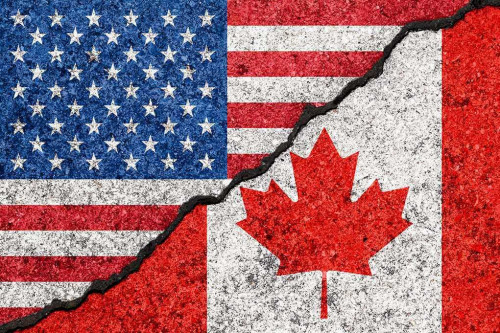ETradZ News  
After the Split: Canada’s Global Trade Pivot in a Post-Free Trade Era with the U.S.
Date Of Article: 02/05/2025
The end of Canada's long-standing free trade agreement with the United States marks a turning point in North American economic history. For decades,
the Canada-U.S. Free Trade Agreement (and its successor, NAFTA, later replaced by CUSMA/USMCA) formed the foundation of Canada’s export economy.
With American markets readily accessible, nearly 75% of Canada’s exports flowed south across the border. But recent policy changes and protectionist
shifts in Washington have forced Canada to rethink its economic strategy—and fast.
The Breakdown
Tensions between Canada and the United States over tariffs, subsidies, and regulatory differences have been simmering for years. While each
dispute—from softwood lumber to dairy to auto manufacturing—was individually manageable, the cumulative strain ultimately led to a breakdown in
negotiations to renew or maintain elements of the bilateral trade agreement. With the United States imposing stricter terms on Canadian imports and
threatening penalties for partnerships that don't align with "America First" initiatives, Ottawa saw no path forward under the existing free trade
framework.
Diversifying Trade: A New Economic Imperative
With the U.S. door closing, Canada is accelerating efforts to build stronger trade ties across Europe, Asia, Africa, and South America. Key
initiatives include:
CPTPP (Comprehensive and Progressive Agreement for Trans-Pacific Partnership): Canada is deepening ties with Pacific nations, taking full advantage of
tariff reductions and market access to Japan, Vietnam, Australia, and others.
EU-Canada CETA (Comprehensive Economic and Trade Agreement): Although partially implemented, Canada is working to expand its European partnerships
under CETA to offset the loss of U.S. market access.
Africa and South America: Canada is actively negotiating new bilateral agreements with emerging economies in Africa and Latin America. These regions
offer untapped markets for Canadian technology, agriculture, and natural resources.
India and ASEAN: Ottawa is pursuing a trade deal with India and strengthening its ties with the Association of Southeast Asian Nations (ASEAN),
viewing the Indo-Pacific as a crucial growth zone.
Domestic Industry Repositioning
The shift away from U.S.-centric trade also means a rethinking of how Canadian businesses operate. Federal and provincial governments are offering
incentives to help exporters access new markets, adapt to new regulations, and modernize their operations for global competitiveness. From clean tech
and AI to green mining and sustainable agriculture, Canada is positioning itself as a reliable and ethical trade partner for the 21st century.
Infrastructure and Diplomatic Expansion
To support this global pivot, Canada is investing in trade infrastructure—modern ports, improved rail links, and digital trade platforms.
Diplomatically, Canada is expanding its trade missions and diplomatic presence abroad to advocate for Canadian business interests and strengthen
global alliances.
A Risky Gamble or the Future of Canadian Prosperity?
Critics warn that cutting economic ties with the U.S., Canada’s largest and closest trade partner, carries significant short-term risks: job losses,
market uncertainty, and currency instability. Yet, supporters argue this moment offers a long-overdue opportunity for Canada to reduce its dependence
on a single market and embrace a more balanced, resilient global trade strategy.
As the dust settles, one thing is clear—Canada is no longer placing all its economic eggs in one basket. The road ahead may be challenging, but it
also presents a unique opportunity for reinvention on the world stage.
Author: ca_admin Author ID: 70bcb34 |


